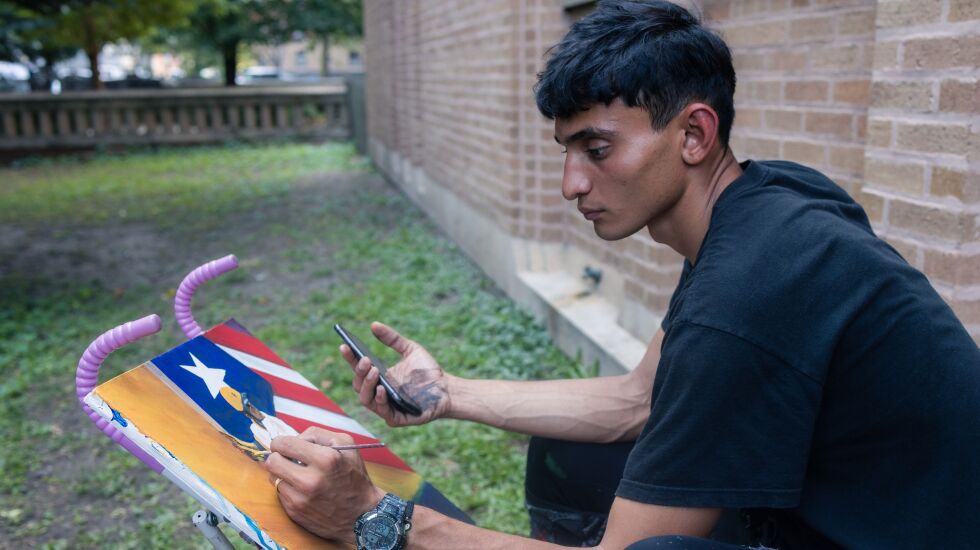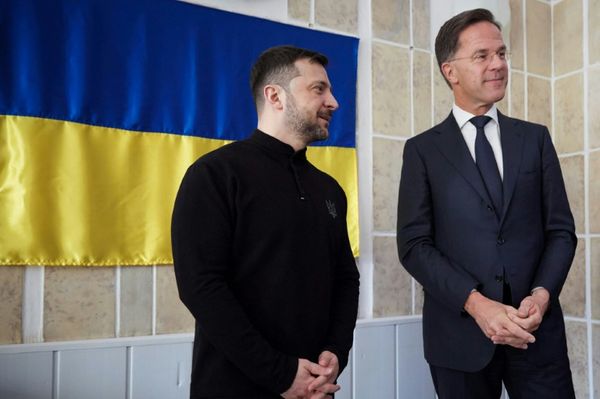
Wilfredo Garcia didn’t know it then, but he began preparing for his trip across Latin America and to Chicago when he first picked up a pencil and started drawing as a child growing up in the Venezuelan heartland.
Garcia began drawing about age 4, realized his talent and began developing it at about 11, and got his first professional gig — painting the exterior of a small business in his hometown — at 15. He’s been painting nearly every day since.
At 23, he’s already done a number of colorful murals for small businesses near the shelters he’s stayed in around Chicago, peppering North Side storefronts with many views of the Caribbean, Andes and plains of his homeland.
“When I was a kid, I was always a dreamer, but I started humbly in my village,” Garcia said. “When I made it to Costa Rica and started painting, I couldn’t believe it. I never dreamed I would do that, much less here in Chicago.”
More than 22,000 migrants have arrived in the city via buses from the border since the summer of 2022, according to city data. Garcia is among thousands fleeing economic and societal ruin in Venezuela. In his short time here, he’s already leaving a bright mark on his new city and country.
He arrived in Chicago a few months ago and soon began picking up jobs near where he was staying at the Albany Park District police station, then by Wilbur Wright College on the Northwest Side — a migrant shelter, briefly — when he moved there and finally at the American Islamic College in Uptown.
It starts with one painting, he said, reflecting on his journey to the U.S. and becoming a full-time painter.
In Albany Park, that was Birrieria el Texcal, 3700 W. Lawrence Ave., an eatery that’s been there for years but whose decoration consisted of its name, blank red walls and photographs of its signature proteins — lamb and goat.
Garcia gave it a colorful reimagining, trading the on-the-nose prints for a stylized goat, an aquamarine blue for the barn-like red and adding a scene of an idealized Angel Falls, the world’s tallest uninterrupted waterfall found in eastern Venezuela.
Owner Jose Alejandre said Garcia walked into the restaurant in June looking for food, and after they got to talking, Garcia showed pictures of his work. Soon, they agreed on a rate for the birrieria — $1,400 for the three-day job to be split among Garcia and his two assistants who clean and prime the walls.
“He charged less for it so that more people would notice it,” said Alejandre, 35. “That same day he was painting, they started asking.”
Examples of that can be found nearby on Lawrence, such as at Joe’s, a grocery owned by a Cuban and Colombian couple, where Garcia’s work reflects those backgrounds.
While working as directed by business owners, parts of Garcia remain throughout his works: vibrant, magical colors with a uniquely Latin American feel and reverence for nature.
That comes from Elorza, Garcia’s hometown in the Venezuelan Llanos, or plains. It’s a small village but culturally significant for being the home of the country’s folk music.
The town’s stories-high Joropo, or harp, monument commemorates that history, and the village’s hometown hero, Jorge Guerrero, commemorates the Llanos lifestyle in paeans, like Bruce Springsteen celebrating working-class life in America.
“It’s the folkloric capital of Venezuela,” Garcia said.
For Garcia, it comes out in the landscape style he’s been developing since age 11.
Still, as he got older and Venezuela began to crumble, he felt he couldn’t stay.
“The situation got very hard,” he said. “Whatever job you wanted, it was impossible to find, you had to move.”
He left for Ecuador in 2021, as the country continued down a path of economic depression more severe than almost any other country, especially among those not at war.
In 2020, real gross domestic product in Venezuela declined by 30%, according to an April 2021 report from the International Monetary Fund. The year before, it had declined by 35%. For comparison, most Latin American and Caribbean countries saw a 7% decline in 2020 and a 0.2% increase in 2019.
Beyond his hometown, Garcia began to appreciate how much of a living he could earn painting, and soon he had enough to travel north with some relatives.
Along the way, he left traces of himself in murals painted for businesses in each of the countries he crossed, from a bar in Costa Rica, where he painted the ceiling and stools, to small businesses in Juarez, Mexico, where he crossed the border.
He crossed April 24, 2023, and the next day he had a gig painting an El Paso piñata store.
That’s where Mario Sifuentes, the pastor of a local church, met him. Sifuentes, 46, found Garcia painting the store right when he was looking for a painter for his church, where for years they had relied on a banner out front advertising the space that needed to be replaced almost annually.
“Right here, in El Paso it’s windy, so the banners fly away,” Sifuentes said. Or they got torn. A recent windstorm, he said, tore half the banner down. He took down the rest before the 30-foot-long, 5-foot-high panel could blow into traffic, but after that he decided to replace the banner one more time — costing about $150 — and look for a painter.
That’s when he found Garcia. The young Venezuelan did the job at a discount because it was a church, but again people noticed.
“They were asking for him,” Sifuentes said. “He got referred to do another painting, then suddenly he was doing more paintings here in El Paso.”
Seeing Garcia’s work take off during his brief Texas sojourn reminded the minister why the arrivals should be welcomed.
“There’s very good immigrants that are very talented, and they can do a lot right here in the U.S.” he said. “That’s what we need right here — positive people.”
Now in a shelter in Chicago, with a steady amount of work, the prospect of finding help with housing through the state on the horizon and the hearing for his asylum case slated for 2024, Garcia feels cautiously optimistic about his future.
He spends his days painting, as the pants he’s wearing take on a rash of colors like a Jackson Pollock canvas, and thinks about the techniques he wants to incorporate into his work next.
“God gives some of us talent, but not many take advantage of it,” he said. “If you don’t put in the dedication and discipline, nothing comes of it. You have to be hungry to outdo yourself, to become more.”

Michael Loria is a staff reporter for the Chicago Sun-Times via Report for America, a not-for-profit journalism program that aims to bolster the paper’s coverage of communities on the South Side and West Side.







